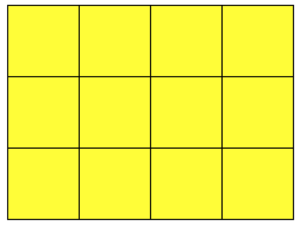In RS2 Level C, Lesson 109, the child is introduced to measuring area. After a problem of square inches is discussed, the lesson shows the child how to write 12 square inches: 12 in². Then, there’s an explanation on the side that reads:
Be sure to read 12 in² as “twelve square inches.” Avoid saying “twelve inches squared,” which has an entirely different meaning.
Kirsten sent us an email and wanted a more complete explanation of the different meaning of twelve inches squared. Good question, Kirsten!
Ok. I will confess I had to go to Dr. Cotter to clarify this for both of us! So here it is.
First, if you say “12 inches,” that’s easy. It’s just 12 inches!

It’s a measurement of area, indicated by the word “square” and the little ². The measurement for the area under discussion is inches. Hence the name “12 square inches,” written by “12 in².”
12² = 144
Extending that, if you say “12 inches squared,” it’s a logical process to square 12 inches, giving us 144 inches.
So “12 inches squared” is a long distance of 144 inches and “12 square inches” is a 3 by 4 inch area. Or 2 by 6. Or 1 by 12. You get my drift.

12 inches squared is 12 inches times 12 inches which makes 144 square inches.
My question is Calvin’s blank art canvas measures 27 inches by 9 inches. which number sentence shows how many square inches he has available to paint?
27 + 9
27-9
27*9
27/9
Hi, Theresa.
The answer would be 27 x 9. He would have 243 square inches available to paint.
My question is
Find the area of the 12 inch square..(the answer will be in squar inches) what is the correct formula for that?
Hi, Joscelym,
The term ’12 square inches’ is referring to area. Area is calculated by the formula w x h (width times height).
The term ’12 inches squared’ is referring to a calculation being made. When you square something, you are multiplying the same number two times. In the case of 12 inches squared, you will be calculating 12 inches x 12 inches. This would not be referring to area, but suggesting that a calculation is to be made. Think of it without the term ‘inches’. Twelve squared would be 12 x 12. The term inches is just informing you that the 12 is a measurement.
I hope that helps! If you have any further questions, please feel free to post them here or email RightStart Math directly at [email protected].
I have a butcher block that measures 24″x24″what is the sq inches
The area would be the length, 24″, multiplied by the width, 24″, which is 576 square inches.
My question is a common floor tile is 12 inches square,meaning,12 inches on all 4 sides.What is the area?
The area would be 12 x 12, or 144 square inches.
I’m confused aren’t they technically the same thing??? what would the answer be if you went 12 inched squared instead of 12 squared inches??? Why do we have to be so specific with math terms they are just words.
Square inches indicates a measurement of area. It’s how area is measured. Inches squared is a “call for action,” meaning the number of inches needs to be multiplied by itself, or squared.
The order of words does matter. Think of a person named Ryan Carter and another named Carter Ryan. They are two different people. The order of the words definitely matters to both Ryan and Carter!
Why in the world does a skillet say it’s 120 square inches?? How many inches is it?
Why not just say 10x 12 or something? Whatever it is????
It’s a marketing tactic, in my opinion. I think 120 square inches sounds like so much more than 10 by 12!
But, that said, it could also be a round skillet that has a diameter of 6.18 or circumference of 38.8. Or a rectangular skillet with rounded corners….